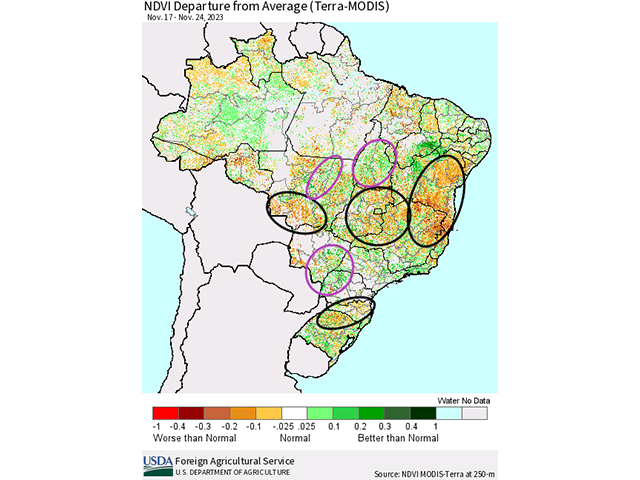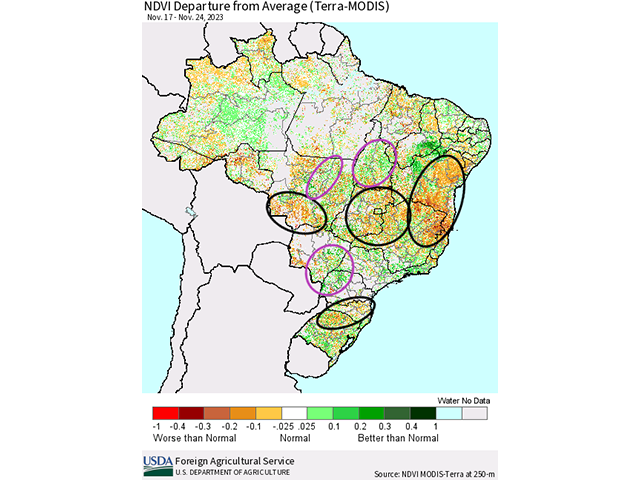South America Calling
Satellite Pictures of Brazil's Crops Show Mixed Bag of Conditions
In the U.S. and most of Canada, we are used to regular reports of crop conditions, pictures, crop tours, media and social media reports. We are used to consistent and constant information about the progress of crop development and the potential concerns or lack thereof. In other countries, that is not always the case, and some other methods are used to fill in the information gap.
One of the most widely used methods is satellite imagery, which covers all areas, not just limited individual reports. The use of these images can help us understand where potential issues or garden spots are located. But they have their own benefits and drawbacks.
In a massive country like Brazil, satellite images can be very useful. Reporting out of these countries is fair. In some areas, it is very good, but in others, it is hard to get much information about the status of the crop, how it is progressing, and what sorts of issues might be arising. This is where images such as the Normalized Difference Vegetation Index (NDVI) can be very useful. The way this works is by taking the difference between the near-infrared and red bands of light and normalizing it. It is just a fancy way of saying the more near-infrared light (which is reflected by healthy green plants) that is picked up by the satellite sensor, the denser and greener that area is. When we compare those values to the average values for this time of year, it can give us an idea of how healthy vegetation is in that area. The accompanying image is such a case for Brazil.
P[L1] D[0x0] M[300x250] OOP[F] ADUNIT[] T[]
The image shows areas in green where NDVI is greater than normal (healthier than normal) and areas in brown where NDVI is less than normal (less healthy). In this image, large sections of the states of Mato Grosso, Goias, Minas Gerais, Bahia and Rio Grande do Sul are shown below normal, circled in black. Those areas could be thought of as having some crop limitations and are less healthy. Across the north, that was due to a lack of rain, across the south, because of too much rain. Areas in green around other spots in Mato Grosso, Tocantins, and western Parana show better than normal plant health, circled in purple.
What this image is suggesting is that conditions are a mixed bag across the country of Brazil. Some areas are doing well while others are doing poorly. It is not as easy to see whether the overall crop health in all of Brazil is below normal, near normal or above normal just by looking at the image. However, we can see small areas that are doing better or worse than others.
While this image can be somewhat useful, it does have some major drawbacks. First and most importantly, these images are delayed by about 15 days. The latest image attached is for conditions between Nov. 17-24. Conditions may have changed between then and now, and likely have been based on the rainfall that has occurred in the last two weeks. Another issue is that when cloud cover is particularly thick, and consistently so, the data can be skewed. Efforts are made to reduce the noise of cloud cover in the images, part of the reason it takes so long to make these images available, but it is not perfect. You can see the widespread lack of data across Brazil with gaps between all the green and brown pixels. Large sections of the Amazon, Mato Grosso do Sul and Parana have these gaps, which makes it impossible to assess crop health.
Also, while crop health is assumed from the overall NDVI, it can be misleading. Because these images are compared to a long-term average, normal planting and crop development are crucial for the images to be accurate. If you have been paying attention to the planting progress in Brazil, planting for both corn and soybeans was slow this season. Crops may just not be as far along as normal, which would skew results lower than they are.
**
To find more international weather conditions and your local forecast from DTN, visit https://www.dtnpf.com/….
John Baranick can be reached at john.baranick@dtn.com.
(c) Copyright 2023 DTN, LLC. All rights reserved.








Comments
To comment, please Log In or Join our Community .